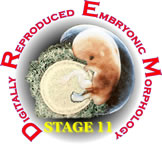

| Opening Screen | Embryo 6344 Figures | Download Section Images |
| Browse Sections | Flythrough Animations | Help / Instructions |
| 3D Models | Credits |
 |
||
|
Stage 11 embryos have a greatest length of 4 to 5 mm and an estimated postfertilization age of 28 to 30 days. There are 13 to 20 pairs of somites or body segments along the body axis. Sclerotomes are forming in the ventromedial part of the somites as the somite remnants move dorsolatterally. The rostral neuropore closes and the optic vesicle forms at the outer part of the optic sulcus in the wall of the diencephalon. The otic placode or pit is present as thickened ectoderm lateral to the rhombencephalon. The adenohypophyseal primordium is forming just rostral to the oropharyngeal membrane that is beginning to disappear. The ectodermal ring is present but interrupted as thickened ectoderm on the lateral surface of the embryo. Right and left horns of the sinus venosus are continuous with their respective atria. The hepatocystic diverticulum can be identified in the endoderm at the fore- mid-gut junction. Mesonephric vesicles and duct appear in the nephrogenic cord. This stage is represented in the DREM databases by Carnegie embryo # 6344 that has a grade of excellent. It was selected for digital replication because it is one of the best transversely sectioned specimens at this stage. The age of the embryo is estimated to be 28 post fertilization days which places it in the early part of the stage. It has a greatest length of 2.5 mm (after fixation) and there are 13 pairs of somites along the body axis. This specimen was collected by Dr. B.S. Kline in April, 1931. The embryo was fixed in formalin and donated to the Department of Embryology at the Carnegie Institution of Washington, where it was preserved in 10% formalin. Following initial examination it was prepared for microscopic examination. It was embedded in 8% celloidin and paraffin, and serially sectioned transverse to the long axis at 6 microns. The 575 sections were mounted on six large glass slides (click for images) and stained with alum cochineal (i.e., carmine). There are 407 sections through the embryo. The morphology of this embryo is well documented in the literature. The Carnegie collection contains reconstructions of the embryo and photographs of it before it was sectioned. The DREM database focuses on 137 of the 407 sections. Approximately every third section has been digitally restored and labeled, and can be viewed at four magnifications (only three zoom levels are available on the CD version). Several 3D reconstructions have been produced from the aligned sections. Animations of the 3D reconstructions of the embryo surface and the internal anatomy together with a flythrough animations of the aligned sections are also included on the disk. For anyone who wishes to use them for other reconstructions, research or presentations, all of the original section images are available as individual .jpg files. These files are zipped as an aligned set of low resolution images, or as zip files of individual slides. Instructions for using the disks can be found by going to the Instructions section from the opening screen. |
||